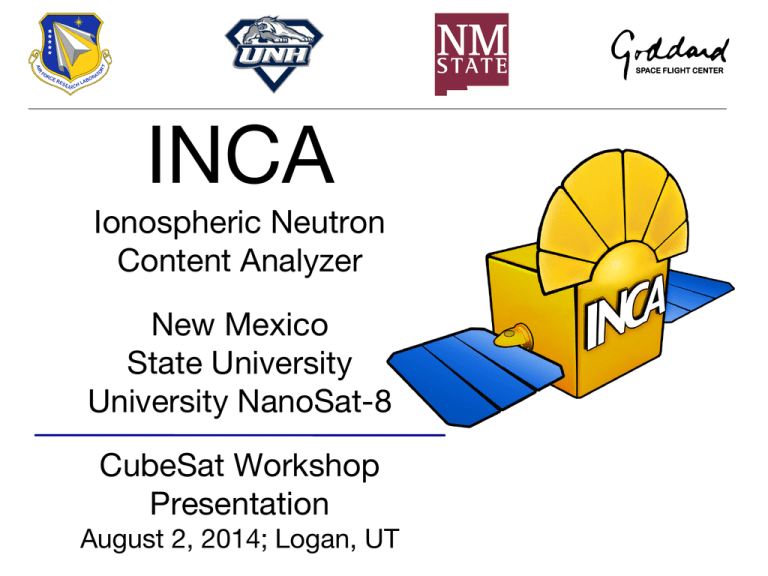Ionospheric Neutron Content Analyzer New Mexico State University
advertisement

INCA Ionospheric Neutron Content Analyzer New Mexico State University University NanoSat-8 CubeSat Workshop Presentation August 2, 2014; Logan, UT Presentation Outline • Mission Overview • Mission Relevance • ConOps • INCA Payload • Subsystem Design • Thanks & Questions * INCA – A Collaboration • AFRL Space Weather Center of Excellence – Contacts: S. White, R. S. Selesnick – Space Weather Forecasters are the Prime Customer • NASA Goddard Space Flight Center – Contacts: Eric Christian, Georgia de Nolfo – Payload Instrument Support & Testing • University of New Hampshire – Contacts: James Ryan, Peter Bloser – Payload Instrument Primary Provider * Mission Overview • Project Objectives – Design and fabricate a small satellite that fulfills the design constraints of the University NanoSat Program and supports the requirements of the UNH Neutron instrument. – Provide professional engineering quality design while maintaining educational responsibilities. • Mission Objectives – PRIMARY: To demonstrate the functionality of Scintillator/SiPM-based neutron spectrometer in Low Earth Orbit. – SECONDARY: To gather neutron flux data and corresponding latitude metadata from at least three latitudinal zones. – TERTIARY: To detect a primary solar neutron event. * Atmospheric Neutrons • Neutron Sources – Air Shower Neutrons – Albedo Neutrons – Solar Neutrons • Payload Detector – – – – Scintillators & SiPMs Solid Angle Time Stamping GPS Stamping * Mission Relevance AFRL’s Space Weather Center of Excellence • Mitigate effects of space environment on systems • Robustness depends on validation of physical observations. NASA Science Directorate • Atmospheric Composition Modeling and Analysis Program (ACMAP) INCA will enhance the robustness of Space Weather models by adding measurements of the neutron spectrum observed in LEO. * Key Measurement Reqs. Measurement Requirement The UNH Instrument shall measure the flux of neutrons in a certain energy range. The UNH Instrument shall measure a minimum number of neutron events. Range/Value Source of Req. 1MeV – 20MeV Customer Proposal 20 MO 1/Uncertainty Calculation 300 MO 2/Uncertainty Calculation The UNH Instrument shall be pointed at the Sun +/- 10 degrees with a certain accuracy. The orientation Metadata (from ADC) shall have +/- 2 degrees a certain accuracy. Customer Q&A Customer Q&A The UNH Instrument shall be monitored with sensors to generate housekeeping data. 20 voltage monitors, 20 current monitors, 3 MO 1/Customer Q&A temperature sensors The longitudinal Metadata (from ADC) shall be gathered by GPS accurate within a certain degree of latitude. 1 Degree MO 2/MO 3/Customer Q&A * Concept of Operations • Launch Sequence. – – – – • • 45-Minute Sleep Period. Activation Sequence. – – – – • System Check. First Transmission. Detumble & Point. Charge Batteries. Science Mission Sequence. – – – • Launch Vehicle Ascends. Eject from Launch Vehicle. Deploy Solar Panel upon launch. Deploy Antennas. Record Data, Metadata. Transmit Data, Metadata. Repeat. End of Life Sequence. INCA Spacecraft Overview • The Basics – 6U (30cm x 20cm x 10cm) Structure – Planetary Systems Corp. Standard – Mainly COTS Parts in Preliminary Design – KISS • The Payload – Being adapted from Solar PRobe Ion Neutron & Gamma-ray Spectrometer (SPRINGS) design – Bus and Payload design happening side-by-side – Pointed in same direction as Solar Array * ADC Subsystem Design Attitude Determination ISIS CubeSense Accuracy : ◦Nadir: 0.18° (where <0.5° over <2° over ± 45° FOV ◦ Sun: <0.3° over <1° over <1.85° over ± 90° FOV Earth is completely ± visible 35° ± ± 40° 60° in Product Properties •Power: 360mW max, <100mW avg •Size: 96mm, 91mm, 10mm (excluding cameras) •Mass: 110g (including cameras) •I2C and UART interface available field-of-view) FOV FOV FOV ADC Subsystem Design Attitude Control ISIS Magnetorquer Board Performance • Actuation level ◦ Max: 0.24 Am2 (@ 20°C, 5V) • Power consumption (@ 20°C) ◦ Torque rods: ~1 Watt/Am2 ◦ Air core: ~2 Watt/Am2 Properties • Two torque rods and one air core torquer • Mass: ~195 grams • Operational temperature range: -40 to +70°C • Dimensions: 95.9 x 90.1 x 15 mm3 • Supply voltage ◦ Actuation: 5V EPS Subsystem Design EPS Board Solar Panels Batteries COM Subsystem Design CDH Subsystem Design Cleanroom & Lab Thanks & Acknowledgments • Monetary Support – New Mexico Space Grants Consortium – Harris Corporation • NMSU Organizations – Physical Sciences Lab – Industrial Engineering Dept. • Special Thanks to – – – – – – – – – – Dr. Steve Stochaj Mr. Bob Hull Sue, Grace, & Annette Dr. Jeanine Cook Dr. Jim Ryan Dr. Peter Bloser Dr. Georgia de Nolfo Ms. Patricia Sullivan Dr. William Godwin Mr. Brian T. Sanders *




